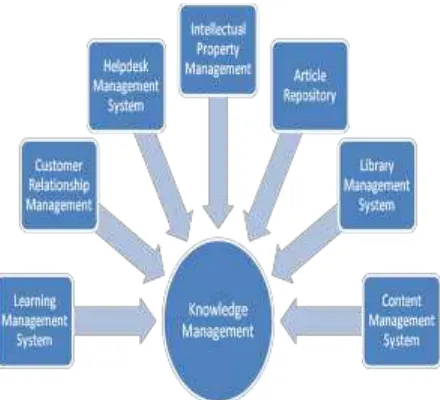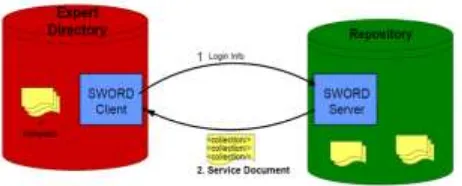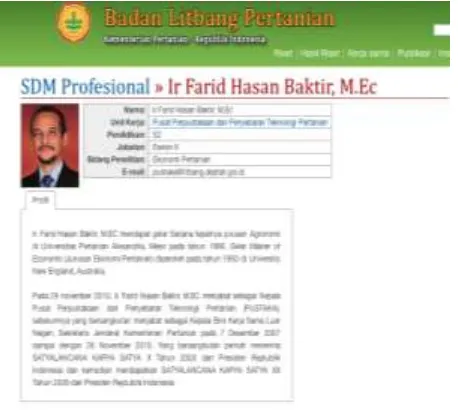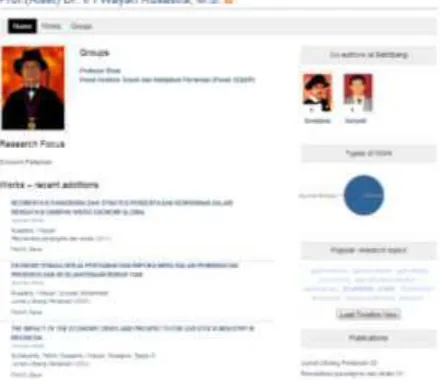182 Proceedings of the 2013 International Conference on Computer Science and Information Technology (CSIT-2013)
SWORD Protocol for Connecting Repositories:
Supporting Knowledge Management for Research Based Institutions
Anindito
Web-service Offering Repository Deposit) protocol in connecting repositories. Organizations that prioritize on efficiency are strongly advised to use IT-based knowledge management system that enhances the use of prior knowledge. The SWORD protocol is designed to connect repositories with similar systems. The current system is examined to determine the feasibility of implementation for the protocol. Connection between the expert directory, repository, human resources, and payroll may improve accuracy of data thus improving research performance and management decision making.Keywords—SWORD, repository, knowledge management.
I. INTRODUCTION
In research and development, knowledge is the most valuable asset. While new knowledge is developed by individuals, organizations play an important role in sharpening and expanding knowledge [1]. Organizations that aim to be successful should not only process information but also create new information and knowledge [2]. The process that needs to be prioritized is to change tacit knowledge into explicit knowledge. This process is the best source of innovation in organizations [3].
Companies that prioritize efficiency are strongly advised to use IT-based knowledge management system that enhances the use of prior knowledge [4]. The process of knowledge management in a large organization is generally reaching distance and time constraints. This combined with a shorter cycle time for the development and innovation of goods / services to make companies need to rely on information and communication technology [5]. The use of information and communication technology to connect units that exist within an organization will improve the knowledge management system. Knowledge management capabilities knowledge management processes, such as: given priorities, relationship between organizational goals and personal goals, and norms related to organizational knowledge sharing and collaboration [8]. They found that the promotion and development is a step that can overcome fragmentation between units within a single organization. Content that is precise and able to support the management decision making proves to be helpful to the development of knowledge management systems [9].
There is a "bottleneck" between research and the general public and thus require means better data dissemination. A centralized repository that includes electronic documents, digital archive and database of Web-based research may be used to address this issue [10]. The repository must be supported by computer-based communications, community support process, decision support, advanced hypermedia features, and conceptual knowledge structures [11]. These tools and techniques should evolve to encourage community members to learn, contribute to, and collectively build a knowledge community. The knowledge gap between experts and non-experts will hinder the improvement of knowledge-based expert, while short distance between peers will help in improving knowledge [12].
183 Proceedings of the 2013 International Conference on Computer Science and Information Technology (CSIT-2013) B. Institutional Repositories
Ever since 2000, many universities and research institutions in the world have implemented institutional repositories. Not all of these institutional repositories have the same goal, but they have more or less the same goal. There are five general purposes of repository institutions [15], which are: (1) archiving own research (pre-print and post-print), (2) management of digital collections, (3) maintenance of digital material, (4) a place for teaching materials, and (5) electronic publications such as e-journals and e-books.
While similar to the storage, a repository is more or less a shared library storage facility whose operations is supported by the system and integrated policy. Multi-institutional aspects, management and integrated operations are important in providing benefits and also distinguishes it from mere storage [14].
C. Knowledge Management Strategy
Many systems have been developed to support knowledge management. An example is content management system that can help spread critical information from an organization and a learning management system that can help the learning centered. In addition, there is customer relationship management systems that helps provide customer data centrally so that there will be similarities between the pattern of client handling the administration and sales. Some of the knowledge management system that is commonly used is shown in Figure 1.
Fig. 1. Sample Knowledge Management Systems
When the knowledge management system is observed, there will be three (3) things that are uniform between the systems. These are human resources, knowledge, and products. All of the current knowledge management systems handle all three with priority on two of them. Table 1 shows the priority matrix of the common source of existing knowledge management.
TABLE 1.HANDLE MATRIX OF KNOWLEDGE MANAGEMENT SYSTEMS
System Name HR Knowledge Products
Learning Management System –
Content Management System –
Library Management System –
Customer Relationship Management –
Helpdesk Management System –
Article Repository –
Intellectual Property Management –
These three components form an integrated knowledge management system in any organization. Knowledge management pyramid in Figure 2 illustrates the relationship between these three knowledge management systems.
Fig. 2. Knowledge Management Pyramid
The proposed knowledge management system should be able to handle all three components. Legacy systems are connected to each other and will be able to be a provider of data for other future applications. The proposed knowledge management system is included in Figure 3.
184 Proceedings of the 2013 International Conference on Computer Science and Information Technology (CSIT-2013)
III. METHODOLOGY
A. Data Mapping
This activity consists of two way communications between researchers and respondents in the form of a focus group discussion.
The material related to the topics presented: (1) Existing system that contains data for use in the Expert Directory and Institutional Repository, (2) Proposed Model for Expert Directory and Institutional Repository, (3) Policy support in implementation of the proposed system, and (4) Direction and strategy development for the Expert Directory and Institutional Repository. Key persons invited are from PUSTAKA, the Library of the Indonesian Agricultural Research and Development Agency from the Ministry of Agriculture.
The dialogue is analyzed resulting in mapping of data flow for use in the system. Then, after verification, this data flow may be further used to plan subsequent process. Usage of this scheme aims to reduce system defects as early as possible. Cost of system repairs may increase to 20% if system defects are not found at the time of the initial requirements analysis [18].
B. Infrastructure Feasibility Study
Development of the Institutional Repository and Expert Directory will require infrastructure feasibility studies. Infrastructure feasibility study is conducted with the IT governance department at the Ministry of Agriculture to determine procurement requirements at PUSTAKA if necessary. It may also require coordination with the Administrative and Household Section to conduct an inventory of existing guidelines for the purpose of the changes or additions that is required in using the proposed system.
Determining which libraries and data sources that may be connected is done. The possibility of connecting to libraries outside the Ministry of Agriculture institutions may contribute to the data such as done in South Korea [19]. Determination of policy needs to be done thoroughly and where appropriate develop cooperation with relevant parties [20].
IV. RESULTS AND DISCUSSIONS
A. Business Process Review
Current ongoing procedures have been conducted for about two years. At first after completing an article, Ministry of Agriculture researchers will send the file to the journal editor-in-chief via email. The editor-in-chief will forward it to the Editorial Board to check its feasibility, whether the topic is appropriate, if the article is written sufficiently, as well as originality of research. If the article meets all of these criteria, the Editorial Board will provide notification to the editor-in-chief that the article deserves to be published. If the article does not meet any of the criteria, the Editorial Board will provide notification to the editor-in-chief that contains the review report for the authors to revise their work, and after revision the article
may be sent back to the editor-in-chief to do the same process again. The article, typically in the form of journal articles will be published in two formats, namely the print version (hard copy) as well as the digital version in the
For researchers from outside Ministry of Agriculture who wants their work published in PUSTAKA managed journals, the processes are more or less the same. Researchers may also send a link for articles that have been published in other institutions via e-mail to PUSTAKA which is forwarded to the Editorial Board. A feasibility check will also be conducted. If it is not feasible then notification will be given that the article may not be published in PUSTAKA, if approved, the link will be immediately published in the repository.
B. Connecting the Expert Directory and Repository
SWORD (Simple Web-service Offering Repository Deposit) protocol is used to connect the Repository with the Expert Directory. To make a deposit file, the SWORD protocol from the Expert Directory sends login info to send the Service Repository and Document Repository contains a collection or a place to store files Experts Directory and conditions to make a deposit file.
Fig. 5. Initiation of the SWORD protocol
185 Proceedings of the 2013 International Conference on Computer Science and Information Technology (CSIT-2013) a link where it keeps the file. The link is stored in the
Expert Directory to be displayed for file download.
Fig. 6. Final phase of the SWORD protocol
Login Info contains the link for the service document
containing and login information, while the Service
Document contains the rules and regulations of the SWORD server. To make a deposit to the Repository, the article is uploaded to the Expert Directory. After verification, the file will be deposited into the Repository.
Expert Directory sends a zip file containing the article
file and mets.xml file containing the metadata of the file.
The content metadata repository is used as an information file to the repository.
In the proposed procedure, researchers may upload the article directly through the Expert Directory (Fig. 7). Then the editor-in-chief will received notification that there is a new article from researcher. The article is forwarded to the Editorial Board to check its feasibility. If the article is worthy to be published, the editor-in-chief will verify the article. If verification is successful the file will be uploaded into the repository and a print version is also made. This procedure adds usability to the Expert Directory that not only show publications and research only, but as a gateway for researchers to propose their article for publication.
Author Editor-in-chief
Editorial Board
Print Version Digital Version
Expert Directory
Fig. 7. Proposed Procedure for Internal Publication
The proposed procedure for external publications is also shown in Figure 8. The editor-in-chief will verify the submitted article. Upon verification, the article will be sent to the repository where the article is further checked by the Repository Team.
Author
Editor-in-chief
Print Version
Repository Expert Directory
External Publication
Repository Team
Fig. 8. Proposed Procedure for External Publication
An expert directory for the Ministry of Agriculture already exists but is still under constant development. The expert directory contains a list of researchers of the Ministry of Agriculture, position, and their work units. Each employee has a profile page that contains some information. This information is in the form of a narrative that leads to their personal data and is not linked to research or their professional work.
Fig. 9. Currently available Expert Directory
C. Data Mapping and Proposed Functionalities
In order to support the SWORD protocol, the current expert directory has to have a table to store metadata of articles related to the researcher. This metadata table will be used as file information during file deposit to the
Repository, and article information in the researcher’s
page of the expert directory.
186 Proceedings of the 2013 International Conference on Computer Science and Information Technology (CSIT-2013)
Fig. 10. Sample Expert Profile Page in BibApp
The administrative system of the Expert Directory should also have a feature to check double publication uploads.
D. Connecting Other Systems
Other systems that may be connected to the Expert Directory are the HR system, and payroll.
Performance of researchers is commonly measured by the number and type of publications they produce [21]. Publications come as a research output which is funded by internal or external grants. Source of funds is usually put in the acknowledgement part of an article whether in journal or conference proceedings. This is used to track the publication back to its research project and furthermore to its funding agency. As an author uploads an article into the Expert Directory and fills in the information regarding a promotions, salary raise, and employment contract evaluations.
Higher education and research institutions compete for research funds which are granted based upon the renowned scientific outlet. Successful storage of an article in the repository may be connected to the payroll system which upon verification may automatically adds the
incentives to the next month’s salary.
V. CONCLUSIONS
The SWORD protocol is a simple yet powerful protocol which may be used to connect repositories to other related applications. Currently, this is not yet implemented in PUSTAKA. In the future, research organizations should consider the usage of SWORD protocol.
Connection between the expert directory, repository, human resources, and payroll may improve accuracy of exchanged data. Since performance of researchers is often measured by number of published articles, this will improve research productivity. Improvement of the Expert Directory may also open collaboration with other research institutes.
Further sample deposit scenarios are already available which may be used on different circumstances [21]. Future research should also consider adopting SWORD version 2 [22].
ACKNOWLEDGMENT
This research is funded by the Indonesian Agency for Agricultural Research and Development. We also convey our gratitude to Fikry Akbar Kirana, Sasha Febri Safithri, and Didik Setiawan for their huge assistance during research.
REFERENCES
[1] I. Nonaka, "A Dynamic Theory of Organizational Knowledge Creation," Organization Science, vol. 5, no. 1, pp. 14-37, 1994. [2] A. C. Inkpen and A. Dinur, "Knowledge management processes
and international joint ventures," Organization Science, vol. 9, no. 4, pp. 454-468, 1998.
[3] S. D. N. Cook and J. S. Brown, "Bridging epistemologies: The generative dance between organizational knowledge and organizational knowing," Organization Science, vol. 10, no. 4, pp. 381-400, 1999.
[4] R. Sabherwal and S. Sabherwal, "Knowledge management using information technology: Determinants of short-term impact on firm value," Decision Sciences, vol. 36, no. 4, pp. 531-567, 2005. [5] M. Alavi and D. E. Leidner, "Review: Knowledge management and knowledge management systems: Conceptual foundations and research issues," MIS Quarterly, vol. 25, no. 1, pp. 107-136, 2001.
[6] H. Tanriverdi, "Information technology relatedness, knowledge management capability, and performance of multibusiness firms," MIS Quarterly, vol. 29, no. 2, pp. 311-334, 2005. [7] S. Gul and T. A. Shah, "Managing Knowledge Repository in
Kashmir: Leap towards a Knowledge Based Society," Trends in
Information Management, vol. 7, no. 1, pp. 41-55, 2011.
187 Proceedings of the 2013 International Conference on Computer Science and Information Technology (CSIT-2013)
education: A knowledge repository approach," Journal of
Computing in Higher Education, vol. 17, no. 1, pp. 116-138, 2005.
[9] R. L. Purvis, V. Sambamurthy and R. W. Zmud, "The
assimilation of knowledge platforms in organizations: An empirical investigation," Organization Science, vol. 12, no. 2, pp. 117-135, 2001.
[10] M. Witt, "Institutional repositories and research data curation in a distributed environment," Library Trends, vol. 57, no. 2, pp. 191-201, 2008.
[11] M. Bieber, D. Engelbart, R. Furuta, S. R. Hiltz, J. Noll and J. Preece, "Toward virtual community knowledge evolution," Journal of Management Information Systems, vol. 18, no. 4, pp. 11-35, 2002.
[12] K. Cho, T. R. Chung, W. R. King and C. Schunn, "Peer-based computer-supported knowledge refinement: An empirical investigation," Communications of the ACM, vol. 51, no. 3, pp. 83-88, 2008.
[13] P. J. Lor, "Preserving African digital resources: is there a role for repository libraries?," Library Management, vol. 26, pp. 63-72, 2005.
[14] P. Genoni, "Towards a national print repository for Australia: where from and where to?," Library Management, vol. 25, no. 3, pp. 241-253, 2008.
[15] F. H. Cervone, "The repository adventure," Library Journal, vol. 129, no. 10, pp. 44-46, 2004.
[16] F. Wang, "Building an open source institutional repository at a small law school library: Is it realistic or unattainable?," Information Technology and Libraries, vol. 36, no. 2, pp. 81-84, 2011.
[17] C. Macilwain, "E-biomed to be launched as a repository for research," Nature, vol. 401, no. 6748, p. 6, 1999.
[18] D. Leffingwell and D. Widrig, Managing software requirements: A use case approach, 2nd ed., Boston: Pearson Education, 2003. [19] E. J. Shin, "Implementing a collaborative digital repository: The
dCollection experience in South Korea," Interlending & Document Supply, vol. 34, no. 4, pp. 160-163, 2006.
[20] J. Saarti, "From printed world to a digital environment: The role of repository libraries in a changing environment," Library Management, vol. 26, no. 1, pp. 26-31, 2005.
[21] M. Polonsky, "What is a research track record?," Australasian Marketing Journal, vol. 16, no. 2, pp. 67-72, 2012.
[22] S. Lewis, P. d. Castro and R. Jones, "SWORD: Facilitating deposit scenarios," D-Lib Magazine, vol. 18, no. 1/2, 2012.



